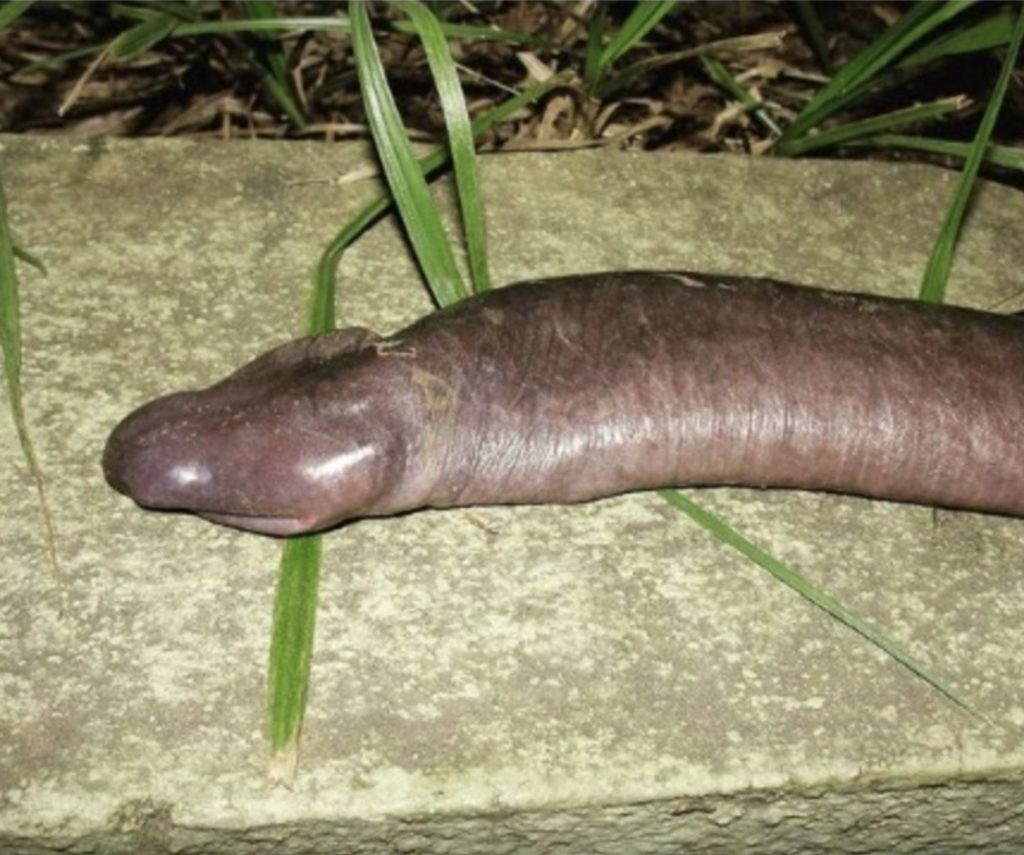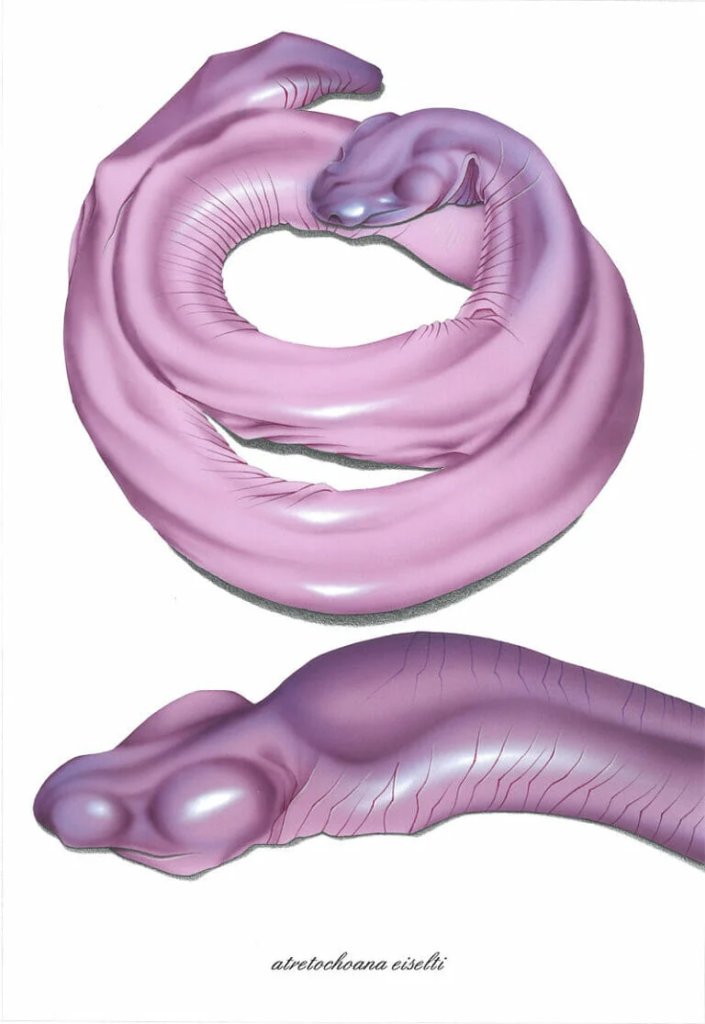
The animal world is full of surprises, with some creatures being more eye-catching than others because of their strange looks or unusual nature.
When I first saw a picture of this weird “penis snake,” I thought it was a joke. But, to my surprise, it turned out to be a real animal. So, let’s dive into the story behind the viral image that has left thousands of people in shock.
Throughout history, anything shaped like a phallus has grabbed attention and sparked curiosity. A few years ago, images of a strange-looking creature started making the rounds online, leaving many people scratching their heads in disbelief.
With its unique appearance, this mysterious animal quickly earned nicknames like the “penis snake,” “blind snake,” or the “man-aconda.”
But no, it’s not what you think.
Even though it looks a lot like a snake, this creature is actually called *Atretochoana eiselti*. It’s not a snake at all, but an amphibian, more closely related to a salamander. It’s also the largest known lungless tetrapod, which means it breathes through its skin instead of lungs.
This rare animal lives in the waters of the Amazon in Brazil and was hard to find for a long time. It was first discovered by Sir Graham Hales during an expedition with Sir Brian Doll in the late 1800s.
However, it wasn’t officially described until 1968. After more research, scientists reclassified it in 1996, giving it its own unique genus, *Atretochoana*.
In 2011, this species was rediscovered in the Amazon region. It lives only in the Amazon River and its largest tributary, the Madeira River in Brazil. The “penis snake” has only been found in this area and nowhere else in the world.
The viral pictures that blew up the internet a few years ago actually came from 2011. That’s when a whole family of these phallic-shaped creatures was found at the bottom of the Madeira River in Brazil. They were discovered when the river was drained during work on a hydroelectric dam.
Julian Tupan, a biologist working with the Santo Antonio Energy company on the dam, explained that not much is known about these lungless, limbless amphibians.
“Out of the six we collected, one died, three were released back into the wild, and two were kept for study,” he told *Estadao*, according to the U.K.’s *The Sun*.
Tupan pointed out that these “snakes” aren’t dangerous and are unlikely to show any aggressive behavior.
“Even though they look like snakes, they’re not reptiles; they’re more closely related to salamanders and frogs. We think the animal breathes through its skin and probably eats small fish and worms, but that hasn’t been proven yet.
“The Amazon is full of surprises when it comes to reptiles and amphibians. There’s still a lot more to discover.”
According to a paper published in the Brazilian scientific journal *Boletim do Museu Paraense Emílio Goeldi: Ciências Naturais*, one of these creatures found in the riverbed was photographed extensively. Some of the animals were released back into the Madeira River, while others were sent to the Emilio Goeldi Paraense Museum in Belem, Brazil.
The most popular photo, which Julian Tupan shared on Instagram, shows an adult female *A. eiselti* that’s just under 40 inches long.
Even though these creatures are fascinating, there’s still a lot we don’t know about them. One mystery that puzzles researchers is their diet. Scientists think these phallic-shaped animals might eat small fish, worms, and other aquatic invertebrates, but more research is needed to confirm this.

Another mystery about these creatures is how they breathe, as scientists haven’t confirmed the method yet. When the six specimens were discovered in 2011, it made things even more puzzling. What’s especially interesting is where they were found— in cold, fast-flowing water with limited oxygen. Since warmer water holds less oxygen, their ability to live without lungs is even more remarkable.
Based on these findings, scientists believe this species might be widespread across the Brazilian Amazon and could even extend into Bolivia.
Nature constantly surprises us with its endless wonders. From the deepest oceans to the tallest mountains, the natural world is full of amazing things waiting to be discovered.
Share this incredible story on Facebook with your friends and family to spark their curiosity and get them talking about the wonders of nature!
I Set up a Hidden Camera in My Living Room to Catch My Husband Cheating — What I Found Out Instead Shattered Me

When my husband started acting strange, I suspected the worst. I decided to get actual proof of his betrayal, but what I discovered broke me down in tears! Luckily, the truth brought us closer than ever.
I had always considered myself a reasonable person, someone who approached situations with a level head. But when it came to my marriage, all that seemed to fly out the window! For weeks, maybe even months, a heavy cloud of doubt hung over my head. I believed my husband was cheating, but when I discovered the actual truth, I was shattered.

An unhappy woman | Source: Midjourney
My husband, Damien, who once filled our home with laughter and light, had changed. He’d become distant, lied about spending our money, and became quiet, almost as if he was retreating into a shell I couldn’t penetrate.
It started small, with missing dinner a couple of times, staying late at work more often than usual, and hiding his phone, which was constantly buzzing with messages he wouldn’t explain.

A man looking at his phone | Source: Freepik
At first, I tried brushing it off. People go through phases, I told myself. Maybe he was just stressed. But as the days turned into weeks, I couldn’t shake the feeling that something was terribly wrong. My mind spiraled into the darkest corners, whispering things I didn’t want to believe.
Was he seeing someone else? Was I losing him? Every time I confronted him, he would look at me with those tired eyes and offer some half-hearted excuse. “It’s just work, Lacy,” he’d say, forcing a smile. “Nothing to worry about.”
But his words felt hollow, and I couldn’t convince myself they were true.

A doubtful woman | Source: Midjourney
The breaking point came one night when he came home long after midnight, reeking of whiskey. He slumped into bed without a word, leaving me wide awake and seething with anger and fear. I needed to know the truth, no matter how ugly it might be.
I’m not proud of what I’ve done, but if you were in my place, you might have done the same thing. I needed to see for myself what was really going on.
I hated the thought of spying on Damien, but the need to know the truth was stronger than the guilt gnawing at my conscience.

A woman deep in thought | Source: Midjourney
The next day, I dusted off my old nanny camera and, with trembling hands, set it up in our living room. I angled it just right so it would capture the entire room without being obvious. I wanted to see what he got up to when I wasn’t around.
I was prepared for the worst-case scenario, catching my husband with some other woman, someone probably younger. But, for the first few days, I couldn’t bring myself to check the footage. I was too afraid of having my greatest fears realized.

A woman setting up a nanny camera | Source: Midjourney
But the tension in our home continued to grow, with Damien becoming more and more withdrawn. I couldn’t take it any longer! One evening, after my husband once again retreated into his silent shell, I sat down with my laptop and pulled up the footage.
My heart pounded as I watched the screen. I saw Damien come home, looking as weary as ever. He didn’t even bother to turn on the lights, just collapsed onto the couch and buried his face in his hands. For a moment, I felt a pang of sympathy, but it was quickly overshadowed by my need for answers.

A woman watching footage on her laptop | Source: Pexels
I fast-forwarded through the footage, watching him sit there, motionless, for what felt like an eternity. And then, he reached into his coat pocket. My breath caught in my throat. I couldn’t believe my eyes as he pulled out an envelope and withdrew a letter, unfolding it with trembling hands.
My dear husband of ten years began to read, and that’s when I saw it… the tears. They started slowly, just a few drops sliding down his cheeks. But soon, his shoulders began to shake, and he crumpled into himself, sobbing quietly in the darkness. I had never seen him cry. Never.

A man crying | Source: Freepik
I stared at the screen, unable to process what I was seeing. There was no other woman, no secret phone calls or messages. Just Damien, alone in the dark, breaking down in a way I had never seen before.
I watched the scene over and over, my mind racing with possibilities. What was in that letter? Why was he hiding this from me? I couldn’t make sense of it, but one thing was clear: I needed to read that letter.

A shocked woman looking at something on her laptop | Source: Pexels
I noted which coat the envelope was in and made it a point to get a hold of it. I woke up in the middle of the night amid my fitful sleep. I couldn’t sleep because I was desperate to see what tragedy had gotten him so torn.
I rushed to where he’d put the letter and grabbed it as he slept. As I read the first lines, MY HEART SANK. There, right next to his name, it said that my husband was dying. Dying… that’s all my eyes could focus on. I couldn’t read anything else…

A shocked woman reading a letter | Source: Midjourney
Confused, I put the envelope back and stayed up, waiting for Damien to wake up, my heart racing with anticipation. By the time he came into the kitchen, he looked even more exhausted than the night before.
His eyes were bloodshot, and there were dark circles under them as if he hadn’t slept in days. “Morning,” he mumbled, pouring himself a cup of coffee. He didn’t look at me, just stared into his cup like it held all the answers in the world.

A tired man holding a cup of coffee in the kitchen | Source: Midjourney
“Damien, we need to talk,” I said, my voice trembling despite my efforts to stay calm.
He looked up at me, and for a moment, I saw a flicker of fear in his eyes. “What’s going on, Lacy?” he asked, his voice wary.
“I saw you last night,” I said, trying to keep my voice steady. “I know about the letter, Damien. I saw you crying. Please, just tell me what’s going on.”
The color drained from his face, and for a moment, I thought he might faint. He set down his coffee cup, his hands shaking, and stared at the table.
“Lacy, I didn’t want you to find out this way,” he whispered.

An upset man | Source: Midjourney
“What’s in the letter?” I pressed, leaning forward. “Please, just tell me the truth.”
He took a deep breath. “I’ve been diagnosed with something,” he finally said, his voice so quiet I almost didn’t hear him. “It’s… it’s not good, Lacy.”
My heart skipped a beat. “What do you mean? What’s wrong?”
Damien looked up at me, his eyes filled with tears. “It’s cancer,” he said, his voice cracking. “Terminal. The doctors gave me six months, maybe less.”

A sad man sharing heartbreaking news | Source: Midjourney
I felt like the floor had just fallen out from under me. The room spun, and I had to grab the edge of the table to steady myself.
“Why didn’t you tell me?” I whispered, my voice breaking. “Why did you try to hide this from me?”
He reached out, taking my hand in his, his grip weak and trembling. “Because I didn’t want you to go through this,” he said, tears streaming down his face. “I didn’t want you to have to watch me die. I thought… I thought if I could just keep it to myself, maybe it would be easier for you.”

An emotional husband hands with his wife | Source: Midjourney
“Easier?” I repeated, my voice rising in disbelief. “How could you think that shutting me out would make this easier? We’re supposed to be a team, Damien. We’re supposed to face things together. You can’t just decide to go through this alone.”
“I know,” he whispered, his voice filled with regret. “I know, and I’m so sorry, my love. I was scared. I didn’t want you to see me like this, weak and broken. I thought I could protect you, but all I did was hurt you.”

A husband explaining himself to his wife | Source: Midjourney
I grabbed him and pulled him in for a tight hug, trying to hold back the tears threatening to spill over.
“You don’t have to protect me from this, babe. I’m your wife. I want to be there for you, no matter what. We’ll face this together, okay? No more secrets.”
He nodded, hugging me back, his eyes filled with gratitude and sorrow. “I don’t deserve you, Lacy,” he whispered, his voice choked with emotion. “But I’m so glad I have you.”

An emotional couple hugging | Source: Midjourney
We held each other like that for a long time, crying for everything we were about to lose. I knew the road ahead would be unbearably hard, but I also knew that we would face it together.
Afterward, I couldn’t stop thinking about all the time we had lost, all the moments we could have spent together if he had just told me the truth. But I knew dwelling on it wouldn’t change anything. What mattered now was that we were in this together.

A woman deep in thought | Source: Midjourney
As the weeks passed, I noticed changes in Damien, both physically and emotionally. He began to open up more, sharing his fears and worries with me! We spent our days trying to make the most of the time we had left, finding small joys in everyday moments!
We went on walks in the park, had movie nights at home, and even started working on a bucket list of things we wanted to do together before it was too late! One day, as we sat on the porch, watching the sunset, my husband turned to me with a sad smile.

A happy couple sitting on the porch | Source: Midjourney
“I wish I had told you sooner, Lacy,” he said quietly. “I’ve wasted so much time hiding from you, from us.”
I shook my head, squeezing his hand. “Don’t think about that now, baby. We’re here together, and that’s what matters. We can’t change the past, but we can make the most of the time we have left.”
He nodded, his eyes glistening with tears. “I don’t want to leave you,” he whispered, his voice breaking. “But I’m so grateful for the time we’ve had. You’ve made these last few months bearable, my bunny. I don’t know how I would have done it without you.”

A happy couple bonding | Source: Midjourney
Tears welled up in my eyes as I leaned in, resting my head on his shoulder.
“You don’t have to do anything alone anymore, my angel. I’m here with you, every step of the way.”
We sat there, wrapped in each other’s arms, as the sun dipped below the horizon. At that moment, I realized something important. I had set out to catch Damien in a betrayal, convinced that he was hiding something terrible from me.
And while I had uncovered a truth far more devastating, it had also brought us closer together than we had been in years. For however long we had left, we would face it together, side by side, just as we always should have.

A couple sharing a happy moment | Source: Midjourney
While Damien wasn’t cheating, in the following story, Ryan’s wife thinks he’s cheating when she finds incriminating evidence in their bedroom. The evidence led her down a rabbit hole when she discovered that she couldn’t trust him anymore. Her fears were finally confirmed when she found proof of his cheating in his car. Her revenge was sweet and swift!
This work is inspired by real events and people, but it has been fictionalized for creative purposes. Names, characters, and details have been changed to protect privacy and enhance the narrative. Any resemblance to actual persons, living or dead, or actual events is purely coincidental and not intended by the author.
The author and publisher make no claims to the accuracy of events or the portrayal of characters and are not liable for any misinterpretation. This story is provided “as is,” and any opinions expressed are those of the characters and do not reflect the views of the author or publisher.



Leave a Reply